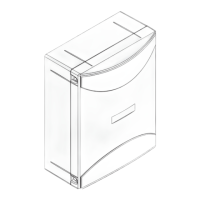MENU FUNCTION
Settable values
ON-OFF-(Default)
MEMO
LOGIC
TST1
The test of photocells to PHOT O input is enabled or disabled.
On: Test is enabled. If the test is negative, no operation is performed.
Off: Test is disabled.
(OFF)
TST2
The test of photocells to PHOT C input is enabled or disabled.
On: Test is enabled. If the test is negative, no operation is performed.
Off: Test is disabled.
(OFF)
PHTC
The operating mode of the PHOT C input is selected.
On: PHOT C input is activated in both opening and closing phases.
In the opening phase: the contact opening causes the motor stop. When the
photocell is released, the motor restarts in the opening phase.
In closing phase: the contact opening causes the motor stop. When the
photocell is released, the motor inverts the movement direction (open).
Off: The PHOT C input is activated in the closing phase only.
In the closing phase: the contact opening causes the motor stop and the
immediate reversion of the operation direction (open).
(OFF)
MENU FUNCTION
RADIO
PP
By selecting this function, the receiver awaits (Push) for a transmitter code to be assigned to the step-by-step
function.
Press the transmitter key to be assigned to this function.
If the code is valid, it is stored in memory and OK appears.
If the code is not valid, the wording Err is displayed.
2ch
By selecting this function, the receiver awaits (Push) for a transmitter code to be assigned to the second radio
channel.
Press the transmitter key to be assigned to this function.
If the code is valid, it is stored in memory and OK appears.
If the code is not valid, the wording Err is displayed.
CLr
By selecting this function, the receiver awaits (Push) for a transmitter code to be erased from memory.
If the code is valid, it is erase and OK appears.
If the code is not valid or is not in memory, the wording Err is displayed.
RTR
Completely erase the receiver memory. Confirmation of operation is required.
MENU FUNCTION
NMAN
Displays the number of complete cycles (open+close) carried out by the automation.
When the <PG> button is pressed for the first time, it displays the first 4 figures, the second time it shows the
last 4. Example <PG> 0012 >>> <PG> 3456: made 123.456 cycles.
RES
RESET of the control unit. ATTENTION!: Returns the control unit to the default values.
Pressing the <PG> button for the first time causes blinking of the letters RES, pressing the <PG> button again
resets the control unit.
Note: The transmitter codes are not erased from the receiver.
Operating mode with enabled/disabled Encoder
ENC LOGICS =ON: anti-crash sensor activated.
If an obstacle is detected, the control unit will control the movement stop and a movement reversion of about 3s.
Adjust sensitiveness through parameters SEAV and SEAR, in compliance with regulations in force.
An accurate adjustment of the motor brake (IBRA parameter) can help to comply with safety regulations in force.
Braking
With TSM parameter higher than 0 (activated braking), the control unit carries out braking by using the Encoder as position sensor.
The first operation is carried out at regular speed, without braking, so as to allow the control unit to learn the stroke length.
Once the stroke has been recorded, the control unit will be able to automatically manage braking phases in both opening and clos-
ing phases. The braking space can be increased or decreased through TSM parameter.
This learning phase is carried out also in case of power failure or when braking is activated (TSM parameter is modified from 0 to a
value higher than 0)
ENC LOGICS =OFF: anti-crash sensor deactivated.
Braking
With TSM parameter higher than 0 (activated braking), the control unit carries out braking by calculating the operating time.
If the first operation starts from a limit switch position, the control unit carries out a complete operation at optimal speed. Braking in
opening and closing phases will start with the following operation. If the operation starts from an intermediate position, the control
unit reaches the limit switch position at normal speed. An operation will be carried out at regular speed until the previous intermedi-
ate position is reached, and then the system will continue its stroke at reduced speed until the limit switch is reached.
The control unit will carry out braking in both opening and closing phases only after this procedure. Braking space can be increased
or decreased through TSM parameter.

